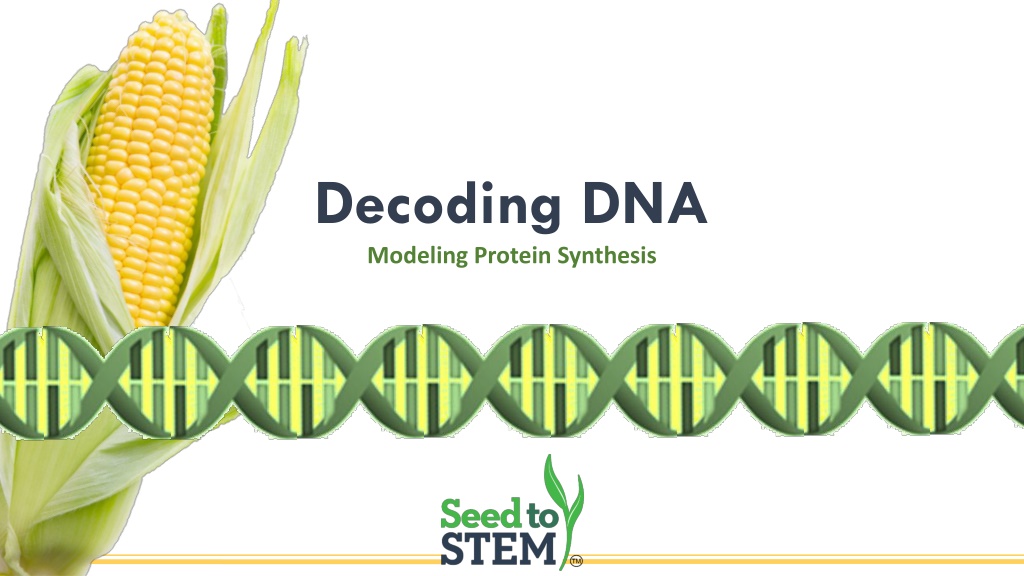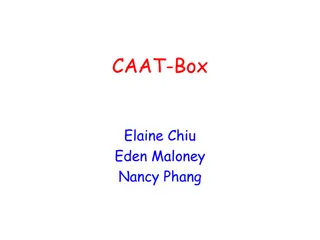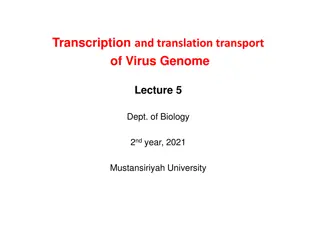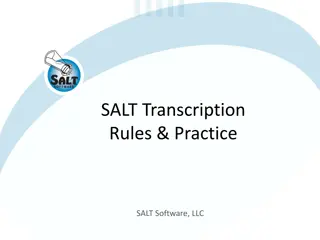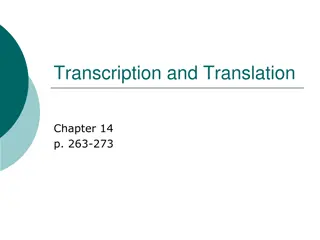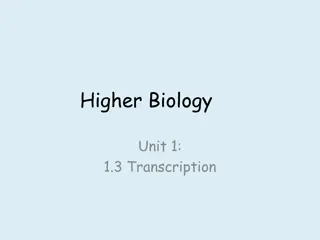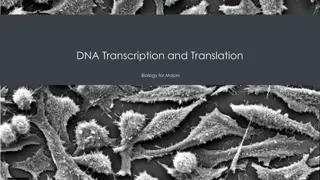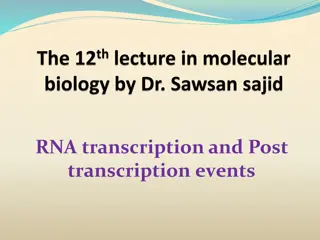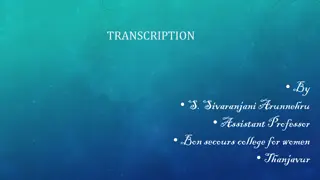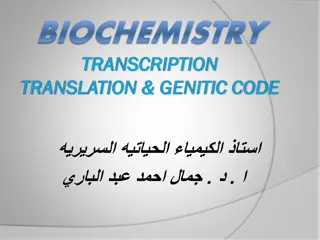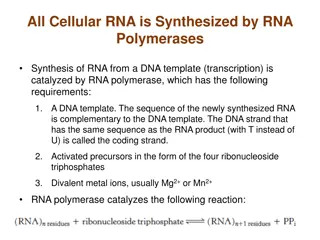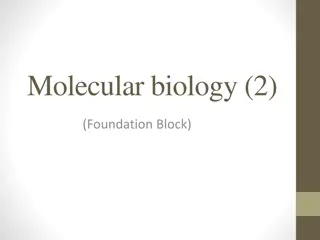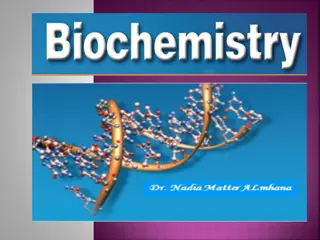Understanding DNA, Transcription, and Translation Process
DNA carries genetic instructions in organisms through nucleotide sequences like A, T, C, and G arranged in a double helix. Transcription converts DNA to mRNA in the nucleus, where RNA polymerase copies the DNA template. mRNA, with U instead of T, carries the genetic message. Translation involves amino acids, tRNAs, ribosomes, and codons to create proteins from mRNA sequences. The process includes initiation, elongation, and termination steps for protein synthesis.
Download Presentation

Please find below an Image/Link to download the presentation.
The content on the website is provided AS IS for your information and personal use only. It may not be sold, licensed, or shared on other websites without obtaining consent from the author. Download presentation by click this link. If you encounter any issues during the download, it is possible that the publisher has removed the file from their server.
E N D
Presentation Transcript
Decoding DNA Modeling Protein Synthesis
A T A C G T A C G A T C G A T C G A T A T G C A T G C T A G C T A G C T DNA carries the genetic instructions for an organism. It is a polymer of four different nucleotides: A, T, C and G. It is arranged in long chains that form a double helix. On each side of the helix is a complementary nucleotide. A pairs with T C pairs with G End of Slide
Transcription: DNA to mRNA RNA polymerase mRNA DNA cannot leave the cell s nucleus RNA polymerase copies DNA to make mRNA Notice that in RNA, A codes for U instead of T. mRNA is a working copy of the DNA that carries DNA s message. End of Slide
Start Codon Translation: mRNA to Protein mRNA mRNA is read in 3 base (letter) sequences called codons. AUG is the Start Codon . After the start codon; each 3 letter sequence is another codon. Each codon codes for one amino acid in the protein. End of Slide
Translation: mRNA to Protein Amino Acid MET MET tRNA is a molecule that translates mRNA into amino acids. On one end of tRNA there is a 3 letter sequence called an anticodon. On the other end tRNA carries an amino acid. tRNA Anticodon U A C U A C End of Slide
Translation: mRNA to Protein HIS MET The process of translation is carried out by a ribosome. The ribosome can hold two pieces of tRNA at a time. When two tRNA molecules are held in a ribosome, their amino acids bond together, forming a protein. U A C GU A Ribosome End of Slide
Translation: Initiation A C A matching tRNA attaches to the AUG start codon. The ribosome attaches to the mRNA where it finds this tRNA attached. End of Slide
Translation: Elongation MET A matching tRNA attaches to the next codon. A bond forms between the amino acids U A C End of Slide
CGA Translation: Elongation HIS MET GU A U A C End of Slide
UCG Translation: Elongation HIS ALA MET GU A CGA End of Slide
Translation: Termination HIS ALA MET SER A stop codon, UAG codes for a tRNA that releases the protein. UCG CGA End of Slide
Translation: Termination HIS STOP ALA SER MET Protein UCG AUC End of Slide
Lab Procedure: Transcription Each group will send one member to the nucleus to pick a DNA strand to transcribe in mRNA. Record the number of the DNA strand as well. Remember DNA has to stay in the nucleus. Gene #1 A T A C G T A C G A T C G A T C G A 1 U A U G C A U G C U A G C U A G C U mRNA # __ End of Slide
Lab Procedure: Translation Leaving the DNA in the nucleus, return to group with mRNA. Working as a group scan mRNA for first AUG (Start Codon) and highlight. Make a mark every three letters after to divide remaining codons. 1 U A U G C A U G C U A G C U A G C U mRNA # __ End of Slide
Lab Procedure: Translation Find the tRNA card with the UAC anticodon and match it with the start codon. (Start) UAC 1 U A U G C A U G C U A G C U A G C U mRNA # __ End of Slide
Lab Procedure: Translation Record the number of the mRNA strand in blank after the sentence #. (Start) UAC 1 U A U G C A U G C U A G C U A G C U mRNA # __ Sentence # 1 End of Slide
Lab Procedure: Translation Find the tRNA card with the anticodon that matches the next codon. the (Start) UAC GUA 1 U A U G C A U G C U A G C U A G C U mRNA # __ Sentence # 1 End of Slide
Lab Procedure: Translation Write the words that are on the cards to complete a sentence. the (Start) UAC GUA 1 U A U G C A U G C U A G C U A G C U mRNA # __ Sentence # 1The . End of Slide
Translation Continue matching anticodons with codons until the sentence is complete. Each sentence should end with a period which represents the stop codon. Another group member will go to the nucleus and transcribe a different DNA strand to be translated by the group. Continue until your group has completed 4 sentences. Have your teacher check your sentences, and correct any mistakes. End of Slide
Genetic Engineering Ask your teacher for a sentence (protein) that would benefit the organism. The sequence of DNA is important. Sentence End of Slide
Genetic Engineering In your group find the cards (tRNA) that would produce the sentence. Don t forget the start or punctuation cards. The sequence of DNA is important. (Start) the sequence of Sentence . is DNA important UAC AAA UUA GUA UGA CUA UUU AAU End of Slide
Genetic Engineering Write the mRNA strand that would code for this sequence of tRNA. (Start) important . sequence of DNA is the UAC CUA UGA UUA AAA GUA AAU UUU mRNA AUGCAUGAUACUAAUUUUUUAAAA End of Slide
Reverse Transcription Write the DNA strand that would code for the mRNA. Remember this is DNA so A codes for T. mRNA AUGCAUGAUACUAAUUUUUUAAAA TACGTACTATGATTAAAAAATTTT DNA End of Slide
Genetic Engineering Have your teacher check your DNA strand. If it is correct, place your DNA strand in the nucleus. End of Slide
